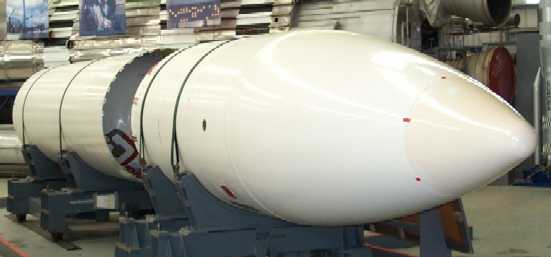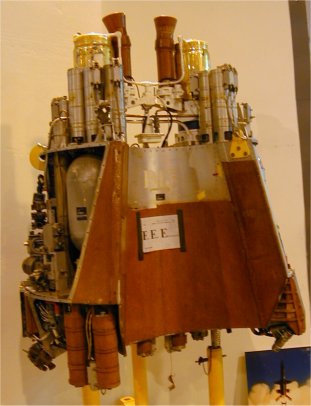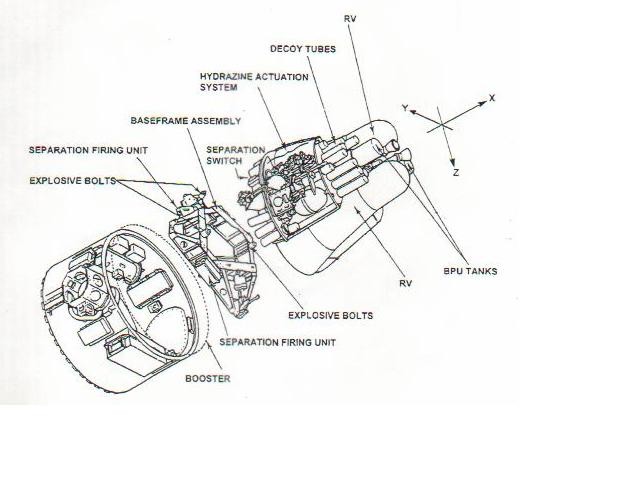From: Allen Thomson ([email protected]) Subject: Re: Polaris Chevaline? Newsgroups: sci.military.naval Date: 2003-07-27 15:22:38 PST This thread has inspired me to do something that I've been thinking of for a while: make available the information about Chevaline that came my way back in the '90s. What follows is pretty clearly somebody's extraction of unclassified pages from a larger report or reports, hence the general messiness. I speculate that this material, which came from a US source, may be associated with interest in buying second-hand Chevalines from the UK for use as target dispensers in missile defense tests. Pages are separated by ----- lines. I've made an attempt to preserve the page lay-out and appearance, but there's a limit to what you can do in ASCII. My comments and descriptions are in [square brackets].

All photos with permission from http://www.skomer.u-net.com/projects/chevaline.htm
----------------------------------------------------------------------
Unclassified
US/UK BALLISTIC PAYLOAD CARRIER SYSTEM
This Carrier System is developed from a proven UK Weapon System and
consists of a fly-away Bus mounted on a baseframe. It is capable of
being flown on a variety of US boost rockets. The Bus is a stable,
manoeuvering platform which can be used for the controlled deployment
of re-enty payloads or other ejectables exo-atmosphere, in variable
sequence depending upon the mission objectives. Post-separation
systems on board the Bus control navigation, stabilisation and event
sequencing.
The System has had full approval for in-service use aboard UK
Submarines and is supported by a series of over forty-five fully
instrumented flights including from the pad at AFETR, Cape Canaveral.
This system and all the necessary supporting equipment is presently
housed at Kirtland Air Force Base under the control of Field Command
- Defense Special Weapons Agency.
Page 1
Unclassified
---------------------------------------------------------------------
DGSWS 5820 [stamped] UNCLASSIFIED
ISSUE 2
ORIGINAL
[Picture of bus looking from above and to the side. Shows two RVs,
one fully, one partially. The one that can be seen best appears to
have some sort of fabric wrapping, leaving only the hemispherical
nose cap uncovered. Lables on the picture are "Attitude Control
Thrusters," "Decoy Tubes" and "Bus Propulsion Unit."]
2-46 FIGURE 2-44 RES MATED -Y SIDE
[stamped] UNCLASSIFIED
DOWNGRADED IN ACCORDANCE TO VAX113/207/ACT(327)
D/MOD SY(S&T)/3/4/3/APPENDIX A67 [handwritten]GW NO:1017675
[squiggle, apparently initials]
[handwritten date] 25/9/96
---------------------------------------------------------------
Unclassified
PHYSICAL CHARACTERISTICS
BUS STRUCTURE
The Bus structure comprises an aluminum closed torsion box with
top and bottom diaphragms, strengthened by vertical divider plates.
A steel base plate provides a payload mounting ring, baseframe
attachment points, and mountings for separation rocket motors and
the Space Reference Unit. Thermal skins protect the Bus components
from residual exit heating effects after nose fairing eject.
The BUS [sic] has integral lifting points to aid assembly.
Approximate Weights and Dimensions:
Overall Carrier length: 1.82 meters 72 inches
Overall Carrier diameter: 1.37 meters 54 inches
Maximum Carrier mass: 735 kg 1620 lb
(including all payloads)
Overall Bus length: 1.27 meters 50 inches
Overall Bus diameter: 1.22 meters 48 inches
Empty Bus mass: 318 Kg [sic] 700 lb
(including fuels but less payload)
Total Payload capacity: 400 Kg [sic] 880 lb
BUS SUB-SYSTEMS
Electronic Control Assembly (ECA)
This electronic unit controls Bus initiation, guidance
and event sequencing and has multiple levels of protection
against disruption (circumvention).
Within its Titanium alloy casing it comprises ;
(i) Power Supply Unit providing DC and AC power up to 200V rms.,
(ii) Guidance Control Computer (hardened with power failure
core store recovery and with programmable missions held in
EEPROM) and
(iii) Interface Control Unit initiating up to seventy-two
ordnance or non-ordnance events.
Space Reference Unit (SRU)
Provides 3-axes attitude, rate and acceleration data to the
ECA. The rate gyroscopes and accelerometer are fixed to the
SRU body and the attitude gyros are caged with reference to
the attitude of the vehicle at Bus separation and all data
can be considered incremental from that datum.
Bus Propulsion Unit (BPU)
Main propulsioin of the Bus is produced by this high
thrust hypergolic liquid rocket motor (fuel MAF-1/oxidant
IRFNA). It provides 6300 N mean thrust (total impulse 77,500
Ns), which can be expended in multiple manoeuvers. Two
nozzles (adjustable) provide different thrust lines to cater
for major c.of g. shifts during a mission.
The BPU features secondary containment of the liquids and is
supplied fully fuelled.
Page 3
Unclassified
--------------------------------------------------------------------
[Line drawing showing top of booster, mounting unit and main PBV assembly.]
[Lables are]
[On booster]: "BOOSTER"
[On mounting unit]: "BASEFRAME ASSEMBLY" "SEPARATION FIRING UNIT"
"EXPLOSIVE BOLTS" "SEPARATION FIRING UNIT" "EXPLOSIVE BOLTS"
[On PBV]: "SEPARATION SWITCH" "HYDRAZINE ACTUATION SYSTEM" "DECOY TUBES"
"RV" "RV" "BPU TANKS"
[There are XYZ coordinate axes in front of the PBV: X is along the line
of flight, Z goes though the line of centers of the RVs, and Y is, of
course, perpendicular to those two.]
-----------------------------------------------------------------
DGSWS 5820 [stamped] UNCLASSIFIED
ISSUE 2
ORIGINAL
[This is a picture similar to the middle one at the bottom of
http://www.skomer.u-net.com/projects/chevaline.htm. Instead of the E.E.E.
sign in the dark part of the RV hollow there's one in the shiny part
just above that has "1062" in big numbers and some smaller text that
I can't make out.]

[stamped UNCLASSIFIED]
FIGURE 2-14 +Z 'C' CONE
2-16 VAX113/20/ACT(327)
DOWNGRADED IN ACCORDANCE TO
D/MOD SY(S&T)/3/4/3/APPENDIX A67
[Initials]
--------------------------------------------------------------------
[seems to be cropped a little at the top]
[stamped UNCLASSIFIED]
ISSUE 2
ORIGINAL
[Picture somewhat similar to the left-hand one in
http://www.skomer.u-net.com/projects/chevaline.htm but taken from further
to the left and closer. The red tank is labled "Hydrazine Tank" and the
things under it are labled "Thermal Batteries." The box to the right of
the tank that's labled DL/CT in the Web picture is labled DB/C on in
the version I have.]

FIGURE 2-32 -Y +Z THERMAL BATTERIES CONNECTED
[STAMPED] UNCLASSIFIED
2-34 VAX113/20/ACT(327)
DOWNGRADED IN ACCORDANCE TO
D/MOD SY(S&T)/3/4/3/APPENDIX A67
[Initials] [handwritten] 25/9/96
----------------------------------------------------------------------
DGSWS 5820 UK/US/EYES ONLY
ISSUE 2 UK SECRET
ORIGINAL UNCLASSIFIED [stamped over above two
lines]
[Picture giving booster-eye view of bottom of PBV. Labels are]: "Attitude
Control Thrusters" "Bus Eject Motor" "Decoy Tubes" "Bus Eject Motor"
"Electronic Unit" "Safety/Arming Plugs"
FIGURE 2-16 -X BOTTOM DIAPHRAGM, ERMs [?] AND DECOYS INSTALLED
UK SECRET
UK/US EYES ONLY
UNCLASSIFIED [stamped over above two lines]
2-28
DOWNGRADED IN ACCORDANCE TO VAX113/207/ACT
D/MOD SY(S&T)/3/4/3/APPENDIX A67 [initials]
-----------------------------------------------------------------
Unclassified
PERFORMANCE
The Bus is a manoeuverable, stabilized vehicle capable of carrying and
ejecting (along pre-planned trajectories) up to 400 kg of payload during
flight. It was designed for the accurate targeting of RVs and exo-atmospheric
placement of pen-aids. It undergoes major displacements and turns
during a mission and is navigated by continuous velocity monitoring
with respect to an inertial reference established just prior to separation.
Utilising the Bus's accuate positioning capability, the dispersal of
objects can be in single or delayed burst modes to produce constellations,
trails, etc, during the exo-atmospheric portion of Bus flight.
FLIGHT TIME
The Bus has onboard thermal batteries which are normally initiated
immediately prior to separation from the booster. These batteries
give the Bus a typical powered flight time of 9 minutes.
Events may be operated later in flight by the use of self powered
firing circuits initiated by a trigger from the ECA.
By the use of additional battery power Bus operations can be extended
up to 20 minutes (governed by hydrazine fuel utilisation).
SEPARATION FROM BOOSTER
The Bus is normally separated from the booster using two solid eject
rocket motors which have a thrust of 24000 N each, imparting a
velocity of 30 m/s with respect to the booster.
Use of soft separation by means of hydraulic rams can give a typical
separation velocity of 5 m/s.
IN-FLIGHT VELOCITY CONTROL, STABILITY AND ACCURACY
During free flight, changes in the velocity of the Bus are achieved
by use of the liquid fuelled BPU. This motor has a mean thrust of
6300 N and a total impulse of 77,500 Ns, and can change the Bus
velocity by up to 0.2 km/s. The BPU is capable of multiple operations
and can be used to control the velocity of the Bus to within 0.1 m/s
The Bus is stabilised in flight by a 3-axis attitude control system
utilising dual level hot gas thrusters. This provides 360 deg steering
in pitch, +/-30 deg steering in yaw and can be controlled
+/-70 deg in roll.
The mean steady state attitude error is typically 0.1 deg under no
load conditions, 0.2 deg during ejection of lightweight object groups
and 0.3 deg during a main engine burn. Following major asymmetric
transient loads, such as RV ejection, the attitude recovers to nominal
within 2 seconds.
The Bus is mass balanced such that the c.of g. always lies within
its stabilisation control box. The gross changes in the c. of g.
which occur during flight are adequately catered for through
corresponding changes to the control system parameters.
Page 5
Unclassified
-----------------------------------------------------------------
Bus Propulsion Unit
[Very poor-quality picture]
A bi-propellant engine providing thrust for gross manoeuvring of the
vehicle in flight. Driven by hot has from the hydrazine actuation
system, it comprises two thrust chambers fed from a pair of tandem
oxidant (nitric acid) and fuel (MAF-1) piston tanks.
It provides velocity increments for the BUS [sic] up to 0.2km/sec.
- 6300 N axial thrust (77,500 NS total impulse)
- Velocity control achieved to within 0.1m/sec.
- Fuel flow rate whan firing 2.5kg/sec.
------------------------------------------------------------------
Unclassified
ENVIRONMENTAL CHARACTERISTICS
The Carrier is a rugged system - designed to meet operational requirements
over a long service life. Total through-life support with re-buy
and refurbishment has maintained the equipment at the bottom of the
failure-rate "bathtub" curve for an extended period. The shock
and vibration qualification test severities imposed for the A3 motors
included substantial margins which have proved adequate to encompass
the enviroments imposed by alternative boosters.
SHOCK
The Carrier has been approved to a shock requirement which equates
to a 1- in -500 probability of occurrence in-service.
LOW LEVEL FLIGHT SHOCK
Half-sine shock levels covering low level flight shock events such
as booster ignition
33g for 35 ms along the X axis
10g for 35 ms along the Y and Z axis
HIGH LEVEL FLIGHT SHOCK
The most severe shocks for items mounted on the Bus and Baseframe
are those arising from the operation of the Bus Separation System.
The Carrier has been approved using the following levels of high
level shock:
[Begin table]
Structural Zone "g" Duration (ms)
Units mounted on the baseframe, 1000 0.25
base structure and lower half 300 0.75
of the base structure
BPU and units mounted on the 300 0.25
Bus lower diaphragm and the ribs 125 1.00
above the lower diaphragm
Equipments mounted on the top 125.00 1.00
diaphragm
[End table]
VIBRATION
The vibration levels utilised in the design and test of the Carrier
equate to a 1-in- 44 probability of the occurrence.
The complete Carrier was designed to be subjected to random vibration
of 0.005 g^2/Hz +/- 3 dB at 20Hz increasingly linearly to 0.03 g^2/Hz
at 500Hz, and 003g^2/Hz over 500Hz to 2kHz, for 40 secs in each of
the 3 missile axes in turn, the levels being controlled at the baseframe.
The majority of carrier components and equipment have been tested to
a "Component" requirement of 0.15 g^2/Hz +/- 3 dB over 20 Hz to
2 kHz for 30 secs in all axes. Equipment not tested to this "Component"
requirement was separately reviewed and found to have substantial margins.
Page 7
Unclassified
--------------------------------------------------------------------
Unclassified
SAFETY
General
The Carrier is equipped with a series of mechanical and electrical
safety breaks. The assembly has been designed so that it will fail
safe should a component failure occur.
Safety Features
The bus is fitted with Safety Plugs for ground handling and processing
which isolate both the pre- and Post-separation power supplies and
must be replaced by Arming Plugs before the mission.
Pre-separation power supply produced in the ECA is safeguarded by pairs
of open contacts on 2 gravity/time sensor switches, each switch
using a different mechanical damping system.
Protection against inadvertent operation of the ordnance is provided
by the use of distribution boxes employing opto- electronic isolation
modules which give complete electrical and physical isolation between
the trigger inputs and outputs. Radio Frequency Attenuation
Connectors (RFACs) transfer the trigger energy to Type E fuseheads
whilst isolating them from other possible sources of energy.
The liquid systems incorporate primary and secondary containment plus
many other safety features, such that at least three unlikely events
would need to occur before the system can be pressurized.
Safe Monitoring
It is possible, subject to operational requirements, to establish
the state of each substantive safety break by visual examination or
safe electrical testing.
APPROVALS
Eastern Space and Missile Center has granted range safety approval
against ESMC Regulation 127-1 for operations at the Eastern Test Range
(ETR) during three phases of the UK In-Service programme:
(a) Flat Pad launches of developmental hardware (1978 - 1980)
(b) Submarne launches of Acceptance standard hardware (1980
- 1982)
(c) Submarine launches of Procuction standard hardware (1982
- 1987)
These approvals include all operations from assembly to launch of the
Carrier.
Outline approval for use of an adaptation of the In-Service system
for launch from NASA, Goddard Space Flight Centre, Wallops Flight
Facility, Va has been granted under GSFC/WFF Range Safety Manual RSM-93.
This approval covers the use of a rail pad launch.
All explosive items have special to type containers with UN clearance
for transport by road and air.
Page 9
Unclassified
----------------------------------------------------------------------

From: Allen Thomson ([email protected]) Subject: Polaris Chevaline? Newsgroups: sci.military.naval Date: 2003-12-30 16:50:47 PST From the Google-cached version of http://www.insys-ltd.co.uk/space/capabilities/capabilities.htm Strategic Systems Involvement in the UK's strategic and tactical nuclear weapons over several decades culminated in INSYS's appointment to the role of Design Authority for the complex Chevaline Penetration Aid Carrier (PAC), during the 1970's UK Polaris Improvement Programme. The PAC was a sophisticated autonomous spacecraft with guidance, 3-axis stabilisation and propulsion. Following a successful series of development and acceptance flights, this entered service with the Royal Navy in the early 1980's. In addition to full development and production responsibilities for the PAC, INSYS exercised major responsibilities for systems aspects associated with the Chevaline project, concerned with mass monitoring and control, rocket plume modelling, sub-system alignment, structural modelling and separation/trajectory modelling. INSYS personnel were members of the analysis teams sent to the US in support of all the development and in-service flight tests. From our background and expertise on the Chevaline, INSYS was in an excellent position to work on behalf of the UK MOD in many aspects of the successor ballistic missile system, Trident. Wide-ranging research and more specific studies were conducted into Trident re-entry performance. Of particular interest is the assessment of re-entry behaviour taking into account the effects of asymmetric aerodynamics caused by ablation and erosion. A legacy from this work was the capability in hypersonic aerodynamics and the state-of-the-art modelling tools for re-entry behaviour. A complete suite of software is available associated with the re-entry performance prediction methodology developed by INSYS. Exo-atmospheric Flight Testing INSYS is the only UK company which regularly designs, develops and flies payloads for the US missile defence programme, currently the responsibility of the US Missile Defence Agency (MDA). This results from US recognition of the INSYS extensive database, and innovative concepts which complement the US activities. Combining the expertise developed in strategic systems with its engineering and maunufacturing capability INSYS became the UK Principal Contractor for the provision of a sophisticated payload on a major UK/US collaborative re-entry vehicle flight experiment, flown on the US STARS booster from Barking Sands launch facility on Kauai. The Contract carried out for DERA (now Dstl), Farnborough involved the design, manufacture, development and qualification of the flight payload which included an instrumentation and telemetry package which provided exceptional flight dynamics data to analysts. INSYS Trials and Safety engineering disciplines were fundamental to the successful flight preparation activities during assembly, integration and test (AIT) and the flight campaign. During the same time period 1990 to 1993, INSYS were design authority for the provision of a number of experimental payloads to other US MDA exoatmospheric flight tests. Re-Entry Vehicles More recently INSYS has been awarded contract by Dstl, Farnborough as UK PC for the development of re-entry vehicles for the US missile defence community. INSYS work closely with US Space and Missile Defense Command who are the launch facilitators and other US sub contractors including Lockheed Martin, Coleman Aerospace/ Orbital Sciences, Ball Aerospace and ITT Industries. Key to INSYS involvement in these programmes was its composite materials and precision manufacturing capability discussed later. The most recent flight test to include an INSYS designed and manufactured re-entry vehicle was in May 2002 when an RV target was provided for a US Patriot PAC3 intercept experiment.
